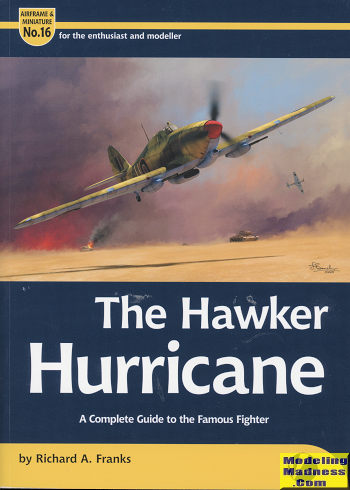 First flying
several years prior to WWII, the Hurricane was the type that was in more
squadrons at the start of WWII than any other British fighter. In many ways, the
Hurricane was the transition aircraft between the RAF's biplane fighters and
modern low wing monoplanes with retractable landing gear and a closed canopy.
Still, it was built in very much the same manner as its biplane predecessor with
a metal tube fuselage covered in fabric aft of the cockpit area with the forward
section covered in metal panels. Early Hurricanes had a wing that was fabric in
the outer panels and sported a fixed two blade wooden prop.
First flying
several years prior to WWII, the Hurricane was the type that was in more
squadrons at the start of WWII than any other British fighter. In many ways, the
Hurricane was the transition aircraft between the RAF's biplane fighters and
modern low wing monoplanes with retractable landing gear and a closed canopy.
Still, it was built in very much the same manner as its biplane predecessor with
a metal tube fuselage covered in fabric aft of the cockpit area with the forward
section covered in metal panels. Early Hurricanes had a wing that was fabric in
the outer panels and sported a fixed two blade wooden prop.
One of the major improvements incorporated in the
Hurricane was the ability to handle a prodigious number of guns in the wing.
Most had 8 30 calibre Colt/Browning machine guns, though they were capable of
holding 12. These guns were a major improvement as they were not subject to
jamming as were the previous British airborne machine guns. Later planes were
able to incorporate 20mm cannon in the wings and some had 40mm guns in wing
pods, making them particularly effective against armor.
Though the Spitfire gets all the glamour when it comes
to the Battle of Britain, it was the Hurricane that was operated by more
squadrons and shot down considerably more enemy aircraft during that period of
time. While the Spitfire was able to stay potent and was vastly improved as the
years went on, for the Hurricane, what you had in the first plane was, despite
increases in engine power, pretty much what you had in the last one built in
1944. Its obsolescence for the European theater did not make it obsolete for
other theaters, such as North Africa, the Mediterranean and in the Far East,
where it was a more than capable fighter and an even better fighter bomber. The
end of the war saw the type rapidly removed from service and within a year it
had almost entirely disappeared from the skies.
This latest book from Valiant Wings follows a familiar
format to all the other Aircraft and Miniatures books. It is much more of a
modelers volume than the other series, which is what makes it so popular. It
starts with an introduction to the type along with its various improvements as
production continued. This leads into evolution section with data on each
upgrade and difference. This includes prototypes and test aircraft. Canadian
production and the Sea Hurricanes are not forgotten and included. We then move
on to one of my favorite sections; colors and markings. The Hurricane family
wore a fairly surprising range of schemes. It includes those operated by non-RAF
air forces.
Next is a section on available kits. The key to this is
available so your old favorites from Frog, for instance, are not covered. The
kit building section provides articles on the new Airfix and Arma Hobby 1/72
kits along with the Hasegawa kit in 1/48 and the Fly kit in 1/32. The section
that provides drawings of every minute difference between Hurricanes starting
from the first to the last and those proposed is next. Very useful. The 'in
detail' section provides lots of images of current museum aircraft as well as
period images and images taken from technical manuals. Then a full listing of
all known Hurricane kits, decals, and books. Finally a great set of fold out
plans in 1/48 scale.
Overall, this makes this THE book to have on the
Hurricane. The amount of information is incredible. It is a book that I can
easily provide my highest recommendation.
January 2021
Copyright ModelingMadness.com. All rights reserved.
For more on Valiant Wings, including getting this book, visit
www.valiant-wings.co.uk. Thank you
for the review copy. You can get yours direct
at
this link.
If you would like your product reviewed fairly and
fairly quickly, please
contact
the editor or see other details in the
Note to
Contributors.
 First flying
several years prior to WWII, the Hurricane was the type that was in more
squadrons at the start of WWII than any other British fighter. In many ways, the
Hurricane was the transition aircraft between the RAF's biplane fighters and
modern low wing monoplanes with retractable landing gear and a closed canopy.
Still, it was built in very much the same manner as its biplane predecessor with
a metal tube fuselage covered in fabric aft of the cockpit area with the forward
section covered in metal panels. Early Hurricanes had a wing that was fabric in
the outer panels and sported a fixed two blade wooden prop.
First flying
several years prior to WWII, the Hurricane was the type that was in more
squadrons at the start of WWII than any other British fighter. In many ways, the
Hurricane was the transition aircraft between the RAF's biplane fighters and
modern low wing monoplanes with retractable landing gear and a closed canopy.
Still, it was built in very much the same manner as its biplane predecessor with
a metal tube fuselage covered in fabric aft of the cockpit area with the forward
section covered in metal panels. Early Hurricanes had a wing that was fabric in
the outer panels and sported a fixed two blade wooden prop.